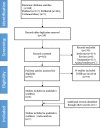Serum inhibin B for differentiating between congenital hypogonadotropic hypogonadism and constitutional delay of growth and puberty: a systematic review and meta-analysis
- PMID: 33464540
- PMCID: PMC8159787
- DOI: 10.1007/s12020-020-02582-0
Serum inhibin B for differentiating between congenital hypogonadotropic hypogonadism and constitutional delay of growth and puberty: a systematic review and meta-analysis
Abstract
Purpose: The distinction between congenital hypogonadotropic hypogonadism (CHH) and constitutional delay of growth and puberty (CDGP) in patients with delayed puberty is difficult to distinguish, but important for timely treatment. The aim of this study is to perform a systematic review and meta-analysis to determine the diagnostic performance of serum inhibin B (INHB) levels for differentiating CHH and CDGP.
Methods: PubMed, EMBASE, and Cochrane Library databases were systematically searched from the date of database inception to November 10, 2019 for studies examining the use of serum INHB to discriminate between CHH and CDGP. Pooled odds ratios (OR), sensitivity, specificity, and 95% confidence intervals (CI) were calculated. The Quality Assessment of Diagnostic Studies-2 (QUADAS-2) was used to assess the quality of the included studies. Sub-analyses were performed including that based on testicular volume (TV) and study design.
Results: Seven studies, comprising of 349 patients (96 CHH and 253 CDGP), were included in the meta-analysis. For differentiating between CHH and CDGP, INHB level exhibited good diagnostic accuracy with a pooled sensitivity of 92% (95% confidence interval [CI]: 0.86-0.96, I2 = 0.4%, p = 0.4343), specificity of 92% (95% CI: 0.88-0.94, I2 = 68.1%, p = 0.0009), and pooled area under the receiver operating characteristic curve (AUC) of 0.9619. The cut-off values of INHB for boys were 56, 66, 80, 96, 94.7, 111, and 113 pg/ml (assay method standardized to Gen II ELISA). Sub-analyses showed that testicular volume and study design could be a source of statistically significant heterogeneity in specificity. In boys with a testicular volume of ≤3 ml, INHB performed well with a sensitivity of 92%, specificity of 98%, and AUC of 0.9956.
Conclusion: INHB exhibits excellent diagnostic efficiency in distinguishing CHH from CDGP, especially in boys with severe puberty deficiency (TV ≤ 3 ml).
Keywords: Congenital hypogonadotropic hypogonadism; Constitutional delay of growth and puberty; Inhibin B; Meta-analysis.
Conflict of interest statement
The authors declare that they have no conflict of interest.
Figures



Similar articles
-
GnRH stimulation testing and serum inhibin B in males: insufficient specificity for discriminating between congenital hypogonadotropic hypogonadism from constitutional delay of growth and puberty.Hum Reprod. 2020 Oct 1;35(10):2312-2322. doi: 10.1093/humrep/deaa185. Hum Reprod. 2020. PMID: 32862222
-
Congenital hypogonadotropic hypogonadism, functional hypogonadotropism or constitutional delay of growth and puberty? An analysis of a large patient series from a single tertiary center.Hum Reprod. 2017 Jan;32(1):147-153. doi: 10.1093/humrep/dew294. Epub 2016 Dec 6. Hum Reprod. 2017. PMID: 27927844
-
Inhibin B, AMH, but not INSL3, IGF1 or DHEAS support differentiation between constitutional delay of growth and puberty and hypogonadotropic hypogonadism.Andrology. 2015 Sep;3(5):882-7. doi: 10.1111/andr.12088. Epub 2015 Aug 12. Andrology. 2015. PMID: 26266675
-
Pubertal delay: the challenge of a timely differential diagnosis between congenital hypogonadotropic hypogonadism and constitutional delay of growth and puberty.Minerva Pediatr. 2020 Aug;72(4):278-287. doi: 10.23736/S0026-4946.20.05860-0. Epub 2020 May 15. Minerva Pediatr. 2020. PMID: 32418410 Review.
-
Clinical review: Distinguishing constitutional delay of growth and puberty from isolated hypogonadotropic hypogonadism: critical appraisal of available diagnostic tests.J Clin Endocrinol Metab. 2012 Sep;97(9):3056-67. doi: 10.1210/jc.2012-1598. Epub 2012 Jun 20. J Clin Endocrinol Metab. 2012. PMID: 22723321 Review.
Cited by
-
[A new way for the differential diagnosis of hypogonadotropic hypogonadism and constitutional delay of puberty in adolescent men aged 13.5-17 years].Probl Endokrinol (Mosk). 2024 Mar 9;70(6):106-117. doi: 10.14341/probl13419. Probl Endokrinol (Mosk). 2024. PMID: 39868453 Free PMC article. Russian.
-
Genetic evaluation supports differential diagnosis in adolescent patients with delayed puberty.Eur J Endocrinol. 2021 Oct 8;185(5):617-627. doi: 10.1530/EJE-21-0387. Eur J Endocrinol. 2021. PMID: 34403359 Free PMC article.
-
Delayed Puberty.Indian J Pediatr. 2023 Jun;90(6):590-597. doi: 10.1007/s12098-023-04577-x. Epub 2023 May 2. Indian J Pediatr. 2023. PMID: 37127825 Review.
-
Key features of puberty onset and progression can help distinguish self-limited delayed puberty from congenital hypogonadotrophic hypogonadism.Front Endocrinol (Lausanne). 2023 Aug 28;14:1226839. doi: 10.3389/fendo.2023.1226839. eCollection 2023. Front Endocrinol (Lausanne). 2023. PMID: 37701896 Free PMC article.
-
Critical appraisal of diagnostic laboratory tests in the evaluation of central precocious puberty.Front Pediatr. 2025 Jan 21;12:1504874. doi: 10.3389/fped.2024.1504874. eCollection 2024. Front Pediatr. 2025. PMID: 39911767 Free PMC article.
References
-
- Palmert MR, Dunkel L. Delayed puberty. N. Engl. J. Med. 2012;366(5):443–453. - PubMed
-
- C. Wei, E.C. Crowne, Recent advances in the understanding and management of delayed puberty. Arch. Dis. Childhood. (2016) 10.1136/archdischild-2014-307963 - PubMed
-
- Boehm U, Bouloux PM, Dattani MT, et al. Expert consensus document: European Consensus Statement on congenital hypogonadotropic hypogonadism–pathogenesis, diagnosis and treatment. Nat. Rev. Endocrinol. 2015;11(9):547–564. - PubMed
Publication types
MeSH terms
Substances
Grants and funding
LinkOut - more resources
Full Text Sources
Other Literature Sources

